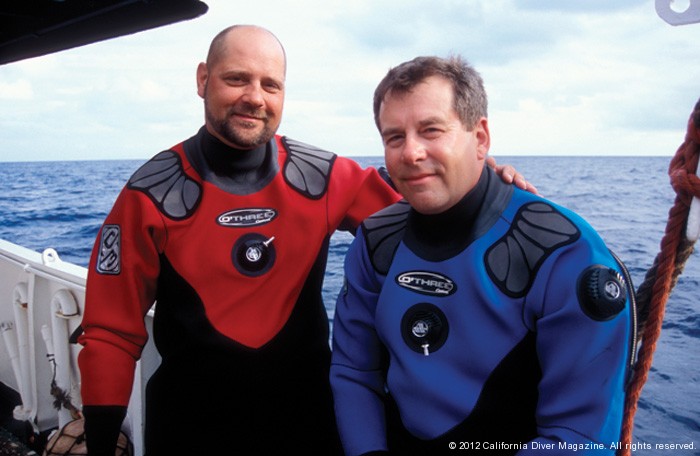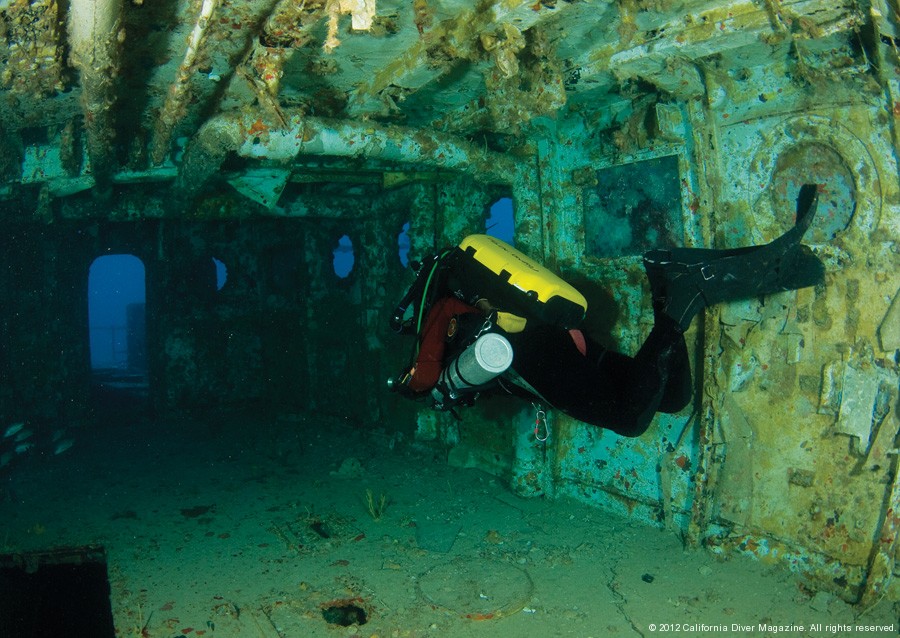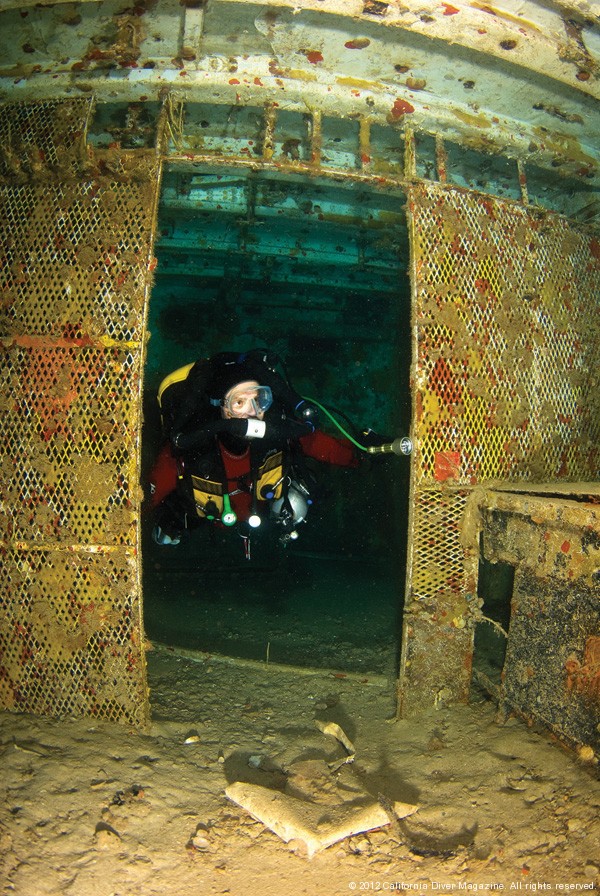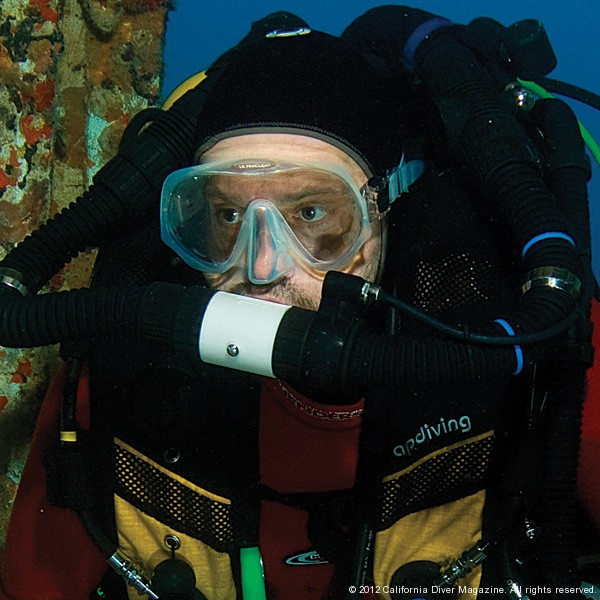Richie Kohler is an experienced technical wreck diver and shipwreck historian who has been diving and exploring shipwrecks since 1980. Together with John Chatterton, Kohler was one of the co-hosts of the television series Deep Sea Detectives on the History Channel, and is also a consultant for the film and television industry on shipwreck and diving projects. [1]
Kohler’s lifelong passion has been exploring the famous shipwrecks around the world, including the SS Andrea Doria and, most recently, the RMS Titanic. Diving from the Russian research vessel Keldysh, Kohler made multiple dives to 3,786 meters (12,421 ft) in the MIR submersibles to explore the wreck site.

Richie Kohler with John Chatterton
Kohler’s work identifying a World War II German Submarine, U-869 off the coast of New Jersey has been the subject of several television documentaries and a best-selling book by Robert Kurson, Shadow Divers. The New York Times bestseller will be a major motion picture by 20th Century Fox, directed and produced by Peter Weir, scheduled for release in 2013. [2]
Richie Kohler is also currently one of the hosts of television series Dive Portal Magazine.
We caught up with him recently to ask him some questions about his past and future projects.
Q: You are best known as the co-host of the television series Deep Sea Detectives on the History Channel, as well as for exploring the most famous shipwrecks around the world, including the SS Andrea Doria and most recently, the RMS Titanic.
What got you interested in wreck diving?
A: When I was fifteen, I was certified as a PADI junior SCUBA diver, and all I wanted to do was be underwater blowing bubbles and exploring. Soon I began spearfishing and lobster diving—that became the focus of my energy. Underwater hunting led me to some wrecks in my (then) home state of Florida. They were really just nondescript rubble piles, totally overgrown with coral and fauna. Time passed and eventually I found myself on a spearfishing trip to North Carolina; I was amazed at the intact sections of some of the wrecks we dove. The same passion I had for underwater hunting was easily redirected to searching and exploring these more intact wrecks, in search of adventure and thrills penetrating into the dark nether-regions and partly looking for artifacts.
Q: How did you and John Chatterton meet, and what was your most memorable dive together?
A: The first time I met John was on an Andrea Doria trip in 1986. There were two dive boats moored above the wreck—the Wahoo and the Seeker. I was diving from the Wahoo and took the boat’s Zodiac over to the Seeker to say hello to some dive buddies and was introduced to some tall skinny guy named John Chatterton. It was the only time in our relationship he was ever quiet. At first, we weren’t friends at all. As a matter of fact, it was quite the opposite. It could’ve been simply that I was from New York and he was from New Jersey, (and in some circles that’s enough), but it actually ran deeper than that. Ten years later we would go from guys who couldn’t stand each other, to pals working shoulder-to-shoulder, all because of a mystery submarine wreck off the New Jersey coast that no government, historian, or expert could identify or explain. This enigmatic shipwreck became our focal point, our common ground. Without fail, the most memorable dive I ever had with John was the day that John recovered dishes bearing the eagle and swastika with the year 1942, that confirmed the mystery submarine to be a World War Two German U-Boat. While we decompressed that day, it dawned on me that only John and I knew this information and that discovery, in effect, began a six-year journey to positively identify the U-Boat [U-869]

Q: The dives you both did on the Titanic revolutionized current thinking at the time on how she broke up and sank—can you tell us a bit about this?
A: Prior to our locating and fully documenting the two large pieces of Titanic’s double-bottom hull, most people believed that Titanic started to flood and then broke up as she sank. The forensic examination by a team of experts and structural analysis of the pieces we documented led us to look further into the survivor testimony and brought our team to a much different conclusion—basically, that Titanic broke apart, and then sank. This was a very different scenario that affected not only the timeline of the sinking, but the choices people made that night about either getting into lifeboats or staying onboard to await [rescue ship] Carpathia. If Titanic had not begun to break up, she may have stayed afloat longer and operated as her own lifeboat, which was what many of the surviving officers felt was possible.
Q: What design flaws did you find in your investigation of the sinking of the Titanic?
A: At the time, the three Olympic class liners, Olympic, Titanic, and Britannic, were the largest moving things ever built and, as such, stressed the designers’ engineering abilities. They were, in effect, experiments based on previous steel shipbuilding techniques and practices. The ships’ architect, Thomas Andrews, had originally designed the Titanic and her sister ships to have thicker steel hulls, and more steel for key support features. But the owners (the White Star line) had overridden Andrew’s concerns. He had the all three vessels constructed with thinner hulls and less steel.
This was within the current industry standards, which, of course, were for much smaller ships and would test the limits of what the existing technology could do. The reason for the design change was a simple business calculation. It would cost much more money in coal to move the heavier ships and affect the White Star Lines’ bottom line. And it was all about money. Other design features that would play a major part in the break up was the location and actual design of expansion joints, a feature that allowed a large ship to “work” in heavy seas and bend rather than crack at the point where the main deck met the hull. These expansion joints were at the epicenter of the breakup and the exact point where the pieces we documented had split apart!
Q: Do you see any parallels with the recent sinking of the Costa Concordia off the coast of Italy?
A: The recent Costa Concordia tragedy illustrates too well that no matter how well designed a passenger vessel is, it is operated by people, and people make mistakes. I think it also painfully shows that passenger vessels are not built like warships, that is, they are not designed to take damage and stay afloat while trained damage-control teams attempt to save the ship.

Q: In 2006, you used a re-breather to dive on the sister ship of the RMS Titanic, HMHS Britannic, which lay at 400 ft off the coast of Greece. What was your purpose in diving HMHS Britannic, and what did you find that shed light on the sinking of the Titanic?
A: We had two mission objectives on the 2006 Britannic expedition. The first was to see if the builders (Harland and Wolf) had quietly made design changes to the expansion joints (of which there is no record) which would indicate that both Harland and Wolf and White Star had reason to believe that Titanic had broken apart on the surface, a claim that was refuted at the time and not realized until the wreck was discovered. The second was penetrate deep into Britannic and try to ascertain why Britannic, with higher water tight compartments, and a double hull, (Titanic had a single hull but double bottom) sank nearly twice as fast as her more famous sister…
Q: We have a 366 ft. Mackenzie-class destroyer in 100 ft of water off the coast of San Diego that was sunk as an artificial reef in 2000 and is home to a lot of marine life now. Do you have an opinion on purposely sinking ships to act as artificial reefs?
A: I think reefing ships is a fantastic win/win/win scenario for sport divers, sport fisherman, and the environment. Natural wrecks break down into rubble piles over time and although they will continue to attract fish, the bigger the structure the bigger the attraction and the bigger the ecosystem it will hold and or attract.
Q: What are you working on now?
A: Well I have a planned return to Britannic this fall, (which is my favorite wreck to dive), [I am] looking for another U-boat off New England, and [I have] a new book in the works about technical dive exploration, so I have to say I’m pretty busy!

Footnotes:
1. en.wikipedia.org/wiki/Richie_Kohler
2. Website: www.richiekohler.com
Interview and story by Michael Bear. Photos by Richie Kohler.
Michael Bear is a PADI Master Diver with over 1000 cold-water dives in California. He is also an active Science Diver with the American Academy of Underwater Sciences [AAUS] and founder of Sevengill Shark Sightings at: http://sevengillsharksightings.org“
